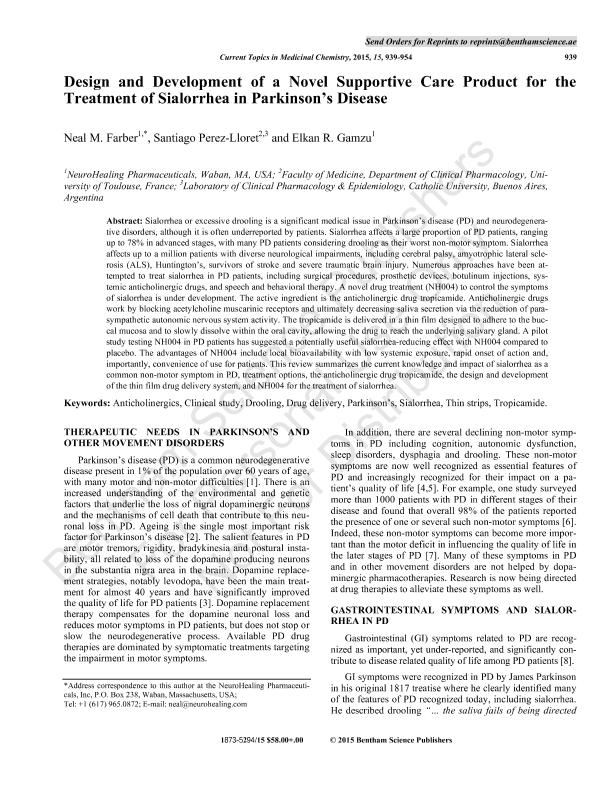Mostrar el registro sencillo del ítem
dc.contributor.author
Farber, Neal M.
dc.contributor.author
Perez Lloret, Santiago

dc.contributor.author
Gamzu, Elkan R.
dc.date.available
2017-05-04T15:05:55Z
dc.date.issued
2015-03
dc.identifier.citation
Farber, Neal M.; Perez Lloret, Santiago; Gamzu, Elkan R.; Design and development of a novel supportive care product for the treatment of sialorrhea in Parkinson's disease; Bentham Science Publishers; Current Topics in Medicinal Chemistry; 15; 10; 3-2015; 939-954
dc.identifier.issn
1568-0266
dc.identifier.uri
http://hdl.handle.net/11336/15957
dc.description.abstract
Sialorrhea or excessive drooling is a significant medical issue in Parkinson’s disease (PD) and neurodegenerative disorders, although it is often underreported by patients. Sialorrhea affects a large proportion of PD patients, ranging up to 78% in advanced stages, with many PD patients considering drooling as their worst non-motor symptom. Sialorrhea affects up to a million patients with diverse neurological impairments, including cerebral palsy, amyotrophic lateral sclerosis (ALS), Huntington’s, survivors of stroke and severe traumatic brain injury. Numerous approaches have been attempted to treat sialorrhea in PD patients, including surgical procedures, prosthetic devices, botulinum injections, systemic anticholinergic drugs, and speech and behavioral therapy. A novel drug treatment (NH004) to control the symptoms of sialorrhea is under development. The active ingredient is the anticholinergic drug tropicamide. Anticholinergic drugs work by blocking acetylcholine muscarinic receptors and ultimately decreasing saliva secretion via the reduction of parasympathetic autonomic nervous system activity. The tropicamide is delivered in a thin film designed to adhere to the buccal mucosa and to slowly dissolve within the oral cavity, allowing the drug to reach the underlying salivary gland. A pilot study testing NH004 in PD patients has suggested a potentially useful sialorrhea-reducing effect with NH004 compared to placebo. The advantages of NH004 include local bioavailability with low systemic exposure, rapid onset of action and, importantly, convenience of use for patients. This review summarizes the current knowledge and impact of sialorrhea as a common non-motor symptom in PD, treatment options, the anticholinergic drug tropicamide, the design and development of the thin film drug delivery system, and NH004 for the treatment of sialorrhea.
dc.format
application/pdf
dc.language.iso
eng
dc.publisher
Bentham Science Publishers

dc.rights
info:eu-repo/semantics/openAccess
dc.rights.uri
https://creativecommons.org/licenses/by-nc-sa/2.5/ar/
dc.subject
Anticholinergics
dc.subject
Clinical Study
dc.subject
Drooling
dc.subject
Drug Delivery
dc.subject
Parkinson’S
dc.subject
Sialorrhea
dc.subject
Thin Strips
dc.subject
Tropicamide
dc.subject.classification
Biotecnología relacionada con la Salud

dc.subject.classification
Biotecnología de la Salud

dc.subject.classification
CIENCIAS MÉDICAS Y DE LA SALUD

dc.title
Design and development of a novel supportive care product for the treatment of sialorrhea in Parkinson's disease
dc.type
info:eu-repo/semantics/article
dc.type
info:ar-repo/semantics/artículo
dc.type
info:eu-repo/semantics/publishedVersion
dc.date.updated
2017-04-28T17:10:41Z
dc.identifier.eissn
1873-5294
dc.journal.volume
15
dc.journal.number
10
dc.journal.pagination
939-954
dc.journal.pais
Emiratos Árabes Unidos

dc.journal.ciudad
Sharjah
dc.description.fil
Fil: Farber, Neal M.. NeuroHealing Pharmaceuticals; Estados Unidos
dc.description.fil
Fil: Perez Lloret, Santiago. Universite de Toulose - Le Mirail; Francia. Pontificia Universidad Católica Argentina "Santa María de Los Buenos Aires"; Argentina. Consejo Nacional de Investigaciones Científicas y Técnicas; Argentina
dc.description.fil
Fil: Gamzu, Elkan R.. NeuroHealing Pharmaceuticals; Estados Unidos
dc.journal.title
Current Topics in Medicinal Chemistry

dc.relation.alternativeid
info:eu-repo/semantics/altIdentifier/url/http://www.eurekaselect.com/129839/article
dc.relation.alternativeid
info:eu-repo/semantics/altIdentifier/doi/http://dx.doi.org/10.2174/156802661510150328224130
Archivos asociados
